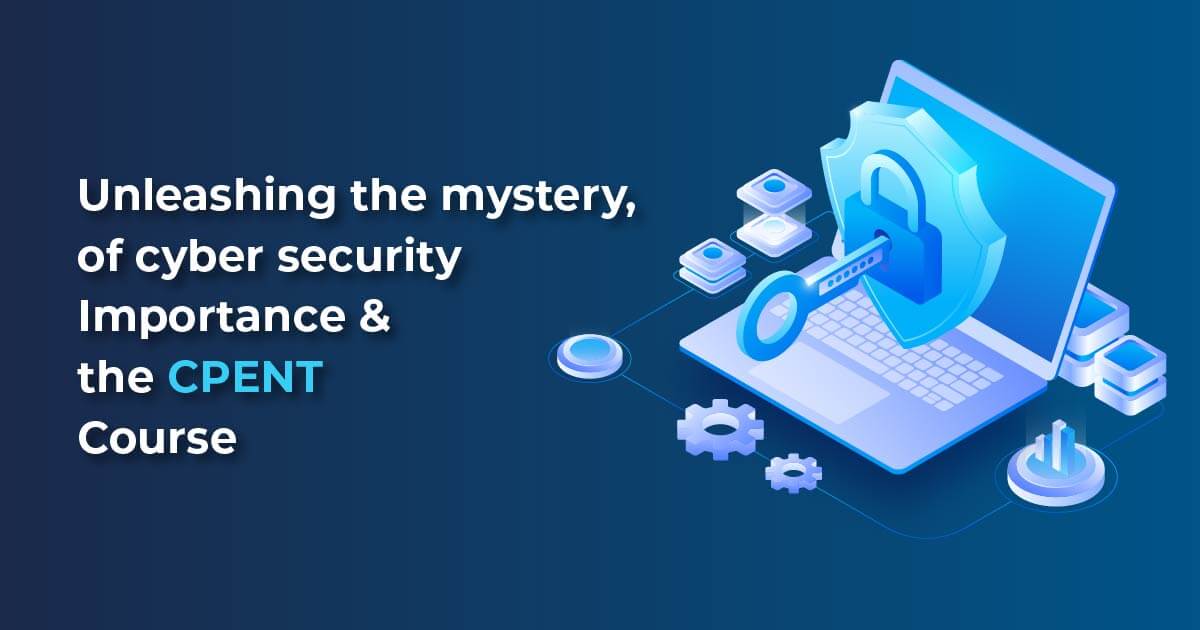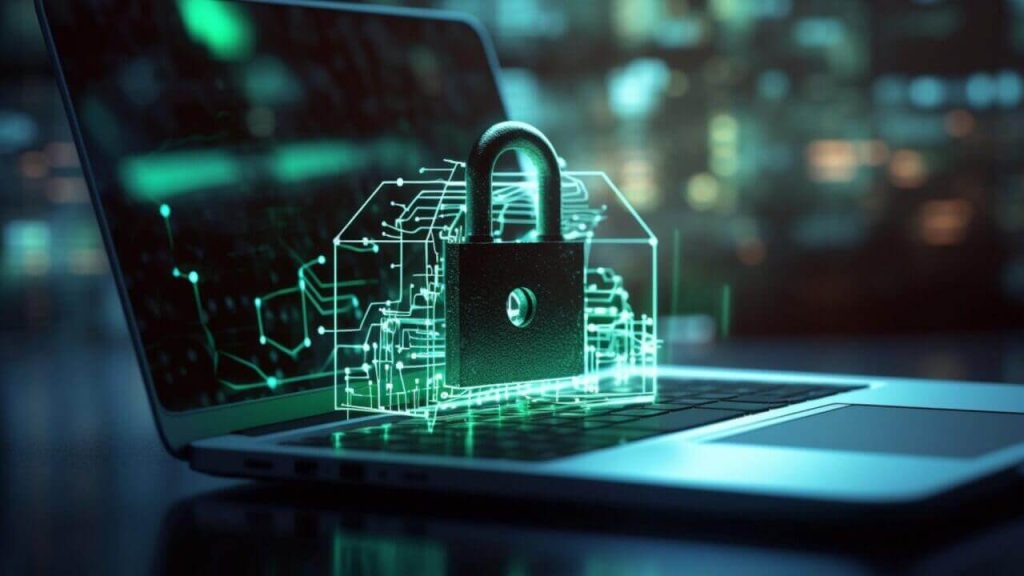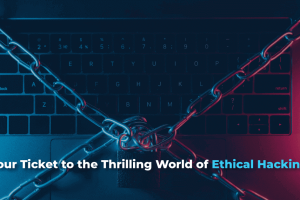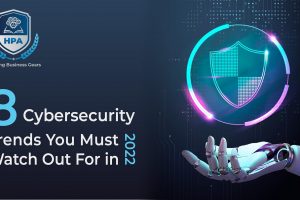
Demystifying Cybersecurity: Importance and the CPENT Course
CPENT Course and Demystifying Cybersecurity: In an interconnected world where our digital footprint continues to expand, This is due to the rapid development that is taking place in the technological field, such as the field of artificial intelligence, the field of Internet of Things, and the field of machine learning. Because of this great development, there has become a great fear of electronic attacks, especially since we are at a time when all our data and information have become available on the Internet. Therefore There is a great need for cybersecurity [ as Cpent ] has become an essential aspect of protecting individuals, businesses, and even nations.
This is because cybercrime has become a major concern for individuals, companies, and governments around the world. As our reliance on technology increases, so do the opportunities for malicious actors to exploit vulnerabilities and cause significant financial damage. To truly understand the seriousness of the situation, it is necessary to examine the compelling statistics that paint an alarming picture of the rising global cost of cybercrime.
Table of Content
- Statistics for some electronic attacks
- Cybercrime also carries a significant intangible burden
- What exactly is cybersecurity, and why is it so important?
- Safeguarding against various cyber threats, such as:
- The significance of cybersecurity is multifaceted:
- Cybersecurity’s impact across society
- The CPENT Course
- FAQ
Here are some staggering numbers that underscore the urgent need to address this critical issue:
1- Financial Impact:
According to Cybersecurity Ventures, the global cost of cybercrime is expected to reach a staggering $10.5 trillion annually by 2025. This represents a significant increase from the $6 trillion estimated in 2021, highlighting the rapid pace at which it is escalating. Cybercrimes.
2- Frequency of attacks:
A report from the IBM Security X-Force Incident Response Team reveals that organizations experience an average of 270 cyberattacks per year. This translates to approximately one attack every two business days, underscoring the ongoing threat organizations face.
3- Ransomware Rampage:
Ransomware, a type of malware that encrypts important data and requires a ransom to decrypt it, is on the rise. The 2023 Coveware Ransomware Report notes that the average ransom payment rose to a record $210,676 in Q3 2023, demonstrating the devastating financial impact of these attacks.
4- Healthcare under siege:
Because patient data is so sensitive, fraudsters have made the healthcare industry their top target. According to the HIPAA Journal, 45 million healthcare data breaches were reported in the United States alone between 2009 and 2023, highlighting the sector’s vulnerability.
Beyond the staggering financial costs, cybercrime also carries a significant intangible burden:
- Erosion of Trust: Repeated data breaches and cyberattacks can erode public trust in companies and organizations, potentially resulting in reputational damage and loss of customers.
- Disruption of critical services: Cyber-attacks can disrupt critical infrastructure and services, putting public safety and well-being at risk.
- Psychological impact: Individuals affected by cybercrime can suffer from psychological disorders, including anxiety, depression, and even post-traumatic stress disorder.
But what is cybersecurity exactly, and why is it so crucial?
The methods and tools used to shield networks, systems, and data from illegal access, use, disclosure, interruption, modification, or destruction are collectively referred to as cybersecurity.
This includes safeguarding against various cyber threats, such as:
♦ Malware/ Malicious software like:
- Viruses: Self-replicating programs that attach themselves to legitimate files and spread through user actions like opening infected attachments or clicking malicious links. They can corrupt data, steal information, or disrupt system functionality.
- Worms: Similar to viruses, they exploit vulnerabilities to spread rapidly across networks, often consuming system resources and causing significant performance issues.
- Trojan horses: Disguised as legitimate software, they trick users into installing them, granting attackers unauthorized access to systems and allowing them to steal data, install additional malware, or disrupt operations.
- Spyware: Covertly monitors user activity, capturing sensitive information like keystrokes, login credentials, and browsing history, which can be used for identity theft or financial gain.
- Ransomware: Encrypts user files, rendering them inaccessible, and demands a ransom payment for decryption. It can cripple individuals and organizations, causing significant financial losses and operational disruptions.
♦Phishing Attacks: A Persistent Threat in the Cybersecurity Landscape:
In the ever-evolving realm of cybersecurity, phishing attacks remain a persistent and prevalent threat. These deceptive attempts to steal sensitive information, such as login credentials or financial details, continue to pose a significant risk to individuals and organizations alike.
Understanding Phishing: How it Works
- Phishing attacks typically involve fraudulent emails, text messages, or even phone calls disguised as legitimate communication from trusted entities like banks, social media platforms, or even colleagues.
These messages often:
- Create a sense of urgency or pressure, urging the recipient to click on a malicious link or download an infected attachment.
- Mimic the branding and language of the purported sender, making them appear genuine at first glance.
- Contain typos or grammatical errors, which may be subtle red flags for vigilant users.
Once the recipient falls victim to the phisher’s tactics, they may be directed to:
- Fake websites are designed to capture login credentials or personal information.
- Download malware that can compromise their device and steal data.
- Forward the phishing attempt to others, inadvertently expanding the reach of the attack.
- The Impact of Phishing Attacks
The consequences of falling prey to a phishing attack can be severe, ranging from:
- Financial loss due to unauthorized access to bank accounts or credit cards.
- Identity theft leads to further financial harm and reputational damage.
- Data breaches compromise sensitive information and potentially impact entire organizations.
- Protecting Yourself from Phishing
♦ Data breaches:
A data breach occurs when unauthorized individuals gain access to and potentially copy, transmit, modify, or delete sensitive data. This information can include a wide range of personal details, such as:
- Personal Identifiable Information (PII): Names, addresses, Social Security numbers, passport information, and driver’s licenses.
- Financial Data: Credit card numbers, bank account details, and investment information.
- Healthcare Data: Medical history, treatment records, and insurance information.
- Corporate Data: Intellectual property, trade secrets, and customer information.
How Do Data Breaches Happen?
Data breaches can occur due to a variety of factors, including:
- Hacking: Malicious actors employ various techniques, like malware deployment or social engineering, to gain unauthorized access to systems.
- Insider Threats: Disgruntled employees or individuals with authorized access intentionally leaking or stealing data.
- Accidental Leaks: Human error, such as sending sensitive information to the wrong recipient or losing a data storage device.
- System Vulnerabilities: Exploiting weaknesses in software, hardware, or network configurations to bypass security measures.

The significance of cybersecurity is multifaceted:
Cybersecurity is no longer an optional concern; it’s a crucial element woven into the fabric of our daily lives. As our reliance on technology continues to surge, the significance of cybersecurity becomes increasingly multifaceted, impacting individuals, businesses, and even national security.
1- Protecting Personal Information:
In today’s digital landscape, our personal information – from financial records to medical data – is often stored electronically. Strong cybersecurity measures are essential to safeguard this sensitive data from unauthorized access, identity theft, and other malicious activities.
2- Ensuring Business Continuity:
Businesses of all sizes rely on their digital infrastructure to operate efficiently. Cyberattacks can disrupt operations, cause financial losses, and damage an organization’s reputation. Implementing robust cybersecurity protocols is vital for businesses to ensure continuity, protect sensitive data, and maintain customer trust.
3- Safeguarding Critical Infrastructure:
Our critical infrastructure, including power grids, transportation systems, and communication networks, is increasingly reliant on interconnected digital systems. Cybersecurity threats to these systems can have far-reaching consequences, potentially disrupting essential services and jeopardizing public safety.
4- Maintaining National Security:
Cyber threats transcend physical borders and pose a risk to national security. Malicious actors can target government agencies, critical infrastructure, and classified information, potentially disrupting essential services and causing widespread chaos. Maintaining robust national cybersecurity is paramount in protecting vital assets and ensuring national security.
Beyond the technical aspects, the significance of cybersecurity extends to various facets of society:
- Economic Impact: Cybercrime is estimated to cost the global economy trillions of dollars annually, highlighting the financial implications of inadequate cybersecurity.
- Privacy Concerns: The increasing collection and storage of personal data online raises privacy concerns. Robust cybersecurity measures are essential to ensure responsible data handling and protect individual privacy rights.
- Public Trust: The public relies on organizations to protect their data and ensure the security of online services. Effective cybersecurity practices are crucial for building and maintaining public trust in the digital world.
Now that you know what the field of cybersecurity is, what are its fields of work?
Here are some other relevant and rewarding career paths to explore:
- Security Analyst: This role involves monitoring networks and systems for suspicious activity, investigating security incidents, and implementing preventative measures to mitigate future threats.
- Security Engineer: Security engineers design and implement security solutions to protect an organization’s IT infrastructure. They have a deep understanding of security principles, technologies, and best practices.
- Incident Responder: Incident responders are the first line of defense when a security breach occurs. They are working quickly to contain the incident, minimize damage and restore normalcy.
- Security Engineer: Security engineers build, deploy, and maintain security tools and technologies. They play a critical role in automating security operations and ensuring the effectiveness of security controls.
- Cybersecurity Consultant: These individuals leverage their expertise to advise organizations on improving their cybersecurity posture. They may conduct risk assessments, recommend security solutions, and help implement security controls.
This list represents just a glimpse of the diverse career landscape in cybersecurity. Each path offers unique challenges, opportunities, and skill sets to explore. By understanding your interests and strengths, you can choose a cybersecurity career path that suits your aspirations and contributes to a safer future.
The CPENT Course: Equipping Professionals for the Challenge
With the ever-growing need for cybersecurity expertise, the Certified Penetration Testing Professional [CPENT course] emerges as a valuable tool for individuals seeking to enter this dynamic field. This globally recognized certification, offered by the EC-Council, equips individuals with the necessary skills to:
- Identify and exploit vulnerabilities within networks and systems, mimicking the methods employed by real-world attackers.
- Conduct penetration testing to assess an organization’s security posture and identify potential weaknesses.
- Recommend and implement effective security measures to mitigate identified risks.
The CPENT course offers several key advantages:
- Hands-on learning: The program emphasizes practical experience through simulated environments and real-world scenarios, preparing graduates for the demands of the job.
- Industry recognition: Earning the CPENT certification demonstrates to potential employers your expertise in penetration testing and ethical hacking, enhancing your career prospects.
- Evolving knowledge base: The curriculum is regularly updated to reflect the latest advancements in cyber threats, ensuring graduates possess the most relevant skills.
Investing in the CPENT course signifies a commitment to a rewarding career path in the ever-evolving field of cybersecurity. By equipping yourself with the necessary knowledge and skills, you can contribute to building a more secure digital future.

FAQ:
1- Is CPENT better than OSCP?
Determining whether CPENT is “better” than OSCP is subjective and depends on your specific career goals and learning style. Both certifications are highly respected in the cybersecurity industry, but they cater to different needs:
CPENT:
- Focus: Advanced penetration testing, real-world scenarios, broader scope (including IOT and OT)
- Target Audience: Experienced penetration testers seeking to expand their skillset
- Benefits: Practical application, in-depth knowledge, industry recognition for advanced expertise
OSCP:
- Focus: Entry-level penetration testing, strong technical foundation, exam-oriented
- Target Audience: Individuals new to penetration testing or seeking a foundational certification
- Benefits: Widely recognized, standardized exam format, strong technical fundamentals
Here’s a table summarizing the key differences:
| Feature |
CPENT |
OSCP |
| Focus | Advanced penetration testing, real-world scenarios | Entry-level penetration testing, technical foundation |
| Target Audience | Experienced penetration testers | Individuals new to penetration testing |
| Benefits | Practical application, in-depth knowledge, industry recognition for advanced expertise | Widely recognized, standardized exam format, strong technical fundamentals |
2- What is the difference between CPENT and CEH?
Both CPENT and CEH are valuable certifications in the cybersecurity field, but they target different audiences and serve distinct purposes:
CPENT (Certified Penetration Testing Professional):
- Focus: Advanced penetration testing. This hands-on certification emphasizes practical skills and real-world scenarios, equipping individuals to identify and exploit vulnerabilities in networks and systems, mimicking the methods of real-world attackers.
- Target Audience: Experienced IT professionals or penetration testers seeking to refine their skills and gain advanced knowledge in this domain.
-
Benefits:
- Practical Experience: Emphasizes hands-on labs, simulated environments, and comprehensive assessments to develop practical skills.
- Industry Recognition: Holds significant weight within the cybersecurity industry, demonstrating advanced expertise in penetration testing.
- Career Advancement: Opens doors to lucrative career opportunities in penetration testing teams.
CEH (Certified Ethical Hacker Course):
- Focus: Broad understanding of ethical hacking concepts and methodologies. This vendor-neutral certification provides a theoretical foundation in various hacking techniques, tools, and methodologies used by both ethical hackers and malicious actors.
- Target Audience: Individuals with some IT background who want to broaden their cybersecurity knowledge or take their first step towards a career in ethical hacking or penetration testing.
-
Benefits:
- Theoretical Knowledge: Provides a comprehensive understanding of various hacking techniques, tools, and methodologies.
- Entry-level Credential: Serves as an entry-level credential for individuals interested in cybersecurity careers.
- Versatility: Applicable to various cybersecurity roles beyond penetration testing, like security analysts or security consultants.
Here’s a table summarizing the key differences:
| Feature |
CPENT |
CEH |
| Focus | Advanced penetration testing | Broad understanding of ethical hacking |
| Target Audience | Experienced IT professionals | Individuals with some IT background |
| Learning Style | Hands-on, practical | Theory-based |
| Benefits | Practical experience, industry recognition, career advancement | Theoretical knowledge, entry-level credential, versatility |
3- What does CPENT stand for?
CPENT stands for Certified Penetration Testing Professional.
It is a globally recognized certification offered by the EC-Council, a prestigious organization in the cybersecurity field. The CPENT program equips individuals with the necessary knowledge and hands-on skills to excel as ethical hackers, also known as penetration testers.
4- What is the equivalent of Cpent?
While there isn’t a direct equivalent to CPENT due to its unique focus on advanced penetration testing and practical applications, other well-respected certifications offer similar career benefits and hold value in the cybersecurity industry. Here are some options to consider depending on your specific goals:
OSCP (Offensive Security Certified Professional): This widely recognized certification emphasizes the technical foundation needed for entry-level penetration testing, focusing on hands-on labs and exam-based assessment. It’s a good starting point for individuals new to the field.
OSCP+, (Offensive Security Certified Professional+): This builds upon the OSCP and delves deeper into advanced penetration testing methodologies and techniques. It requires holding the OSCP and passing a separate exam, catering to individuals seeking further specialization like CPENT.
GIAC Penetration Tester (GPEN): Offered by SANS Institute, GPEN is another highly regarded certification focusing on practical penetration testing skills and methodologies. It shares similarities with CPENT in its hands-on approach and real-world scenarios but may differ in specific content and exam format.
Remember, the “best” equivalent depends on your individual career goals and learning style. Researching each option thoroughly, considering prerequisites, and aligning them with your career aspirations will help you make an informed decision.
5- Is CEH required for CPENT?
While the EC-Council, the organization offering CPENT, does not have a mandatory prerequisite of CEH (Certified Ethical Hacker) certification, they strongly recommend attempting either CEH (Practical) or ECSA (Practical) before taking the CPENT challenge.
Here’s a breakdown of the reasons:
- Knowledge Foundation: CEH or ECSA (Practical) provides a solid foundation in ethical hacking methodologies and tools. This foundational knowledge serves as a building block for the more advanced and practical skills tested in the CPENT exam.
- Bridging the Gap: CPENT dives deep into real-world penetration testing scenarios and hands-on activities. Having the theoretical understanding from CEH or ECSA (Practical) can help you bridge the gap between theoretical knowledge and practical application, which is crucial for success in CPENT.
- Preparation and Confidence: Completing CEH (Practical) or ECSA (Practical) can provide valuable preparation and boost your confidence when approaching the CPENT challenge. These certifications offer practical exercises and assessments that can help you refine your skills and test your preparedness for the more demanding CPENT exam.
However, it’s important to remember that meeting the eligibility criteria for the CPENT exam does not necessitate holding a CEH certification. Ultimately, the decision of whether to obtain CEH (Practical) or ECSA (Practical) before attempting CPENT rests on your individual learning style, career goals, and existing knowledge base.
6- How hard is the CPENT exam?
The difficulty of the CPENT exam is widely acknowledged as challenging, even for experienced IT professionals and penetration testers. Here’s a breakdown of factors contributing to its perceived difficulty:
- Focus on Practical Application: Unlike some certifications that primarily rely on theoretical knowledge, CPENT heavily emphasizes hands-on experience and real-world scenarios. This practical approach requires participants to think critically, apply their knowledge to solve problems and adapt to various simulated environments.
- Advanced Skills and Techniques: The exam assesses individuals on their ability to utilize advanced penetration testing methodologies and techniques. This goes beyond basic vulnerability identification and exploitation, requiring a deeper understanding of exploit development, post-exploitation activities, and advanced attack vectors.
- Time-Constrained Environment: The CPENT exam simulates real-world pressure by placing participants in a time-limited environment. This adds another layer of difficulty, requiring individuals to work efficiently, manage their time effectively, and make sound decisions under pressure.
However, it’s important to remember that difficulty is subjective and can vary based on individual factors like:
- Prior experience: Individuals with extensive experience in penetration testing or a strong foundation in cybersecurity concepts might find the exam less challenging compared to those with limited experience.
- Learning style: Those comfortable with hands-on learning and practical application might find the exam format more suitable, making it potentially less difficult for them.
- Preparation level: Adequate preparation, including thorough studying, practical exercises, and practice exams, can significantly increase your chances of success, making the exam seem less daunting.
Overall, while the CPENT exam presents a significant challenge, it’s not insurmountable. With proper preparation, dedication, and the necessary skill set, individuals can successfully navigate this demanding exam and earn the highly respected CPENT certification.
7- What is the duration of the CPENT examination?
The CPENT exam offers two options for completion, each with a different duration:
- 24-hour single session: This is the most challenging option, requiring you to dedicate a full 24 hours to the exam. It’s designed for individuals who prefer to complete the entire challenge in one go.
- Two 12-hour sessions: This option allows you to split the exam into two manageable 12-hour sessions, potentially offering more flexibility for scheduling and managing your time.
The specific format you choose depends on your personal preference, learning style, and time management capabilities. Both options present a rigorous challenge, requiring a focus
At the end, choosing HPA Academy is a perfect choice for individuals and corporate looking to develop and enhance their performance through different training courses, as HPA has extensive experience, high professionalism, and advanced technologies in this field.
To know more details about Cyber Security Courses and Cpent Certification, Contact us now.




